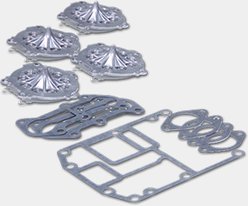Inshore saltwater fishing is wildly popular in coastal states, with trends indicating more anglers taking up this form of fishing than any other. And why not? Access is possible to everyone interested, with waders, paddle enthusiasts and boaters all getting a fair shot.
Inshore fish are hard-fighting and tasty, but sometimes tricky to catch. That’s why it helps to understand a little about the most popular species before you start stocking up on tackle.
Spotted Seatrout
One of the most popular inshore game fish, “trout” live in backwaters and out on the ocean proper, but usually stick to shallow flats within a mile of the coast. Beds of seagrasses are favorite places for trout to feed. In colder weather, trout often group in deeper channels with limited current. Small trout eat minnows and shrimp, while larger trout like pinfish and mullet.
Redfish
Popular with tournament anglers, redfish can be thought of as the largemouth bass of inshore fishes, but with an attitude. Redfish are awesome fighters and will bulldog their way through the mangroves just to break your line. With their mouth positioned on the bottom of their face, redfish (a drum species) often feed on the bottom. They’re suckers for small crabs around oyster bars and will rise and sock a fleeing fish, too.
Snook
Snook are the true trophy fish of inshore anglers, with sizes reaching 30 pounds. Inshore snook frequently go back and forth to the ocean, making inlets good spots to find them. Snook almost exclusively eat big baitfish, gulping it down with their bucket mouths.
Flounder
Flounder like to hang in shallow depressions and behind cover, where they wait to pounce on any unsuspecting prey washed by in the current. Moving water is no problem for the flounder thanks to its flat body, which allows it to lie flat on the bottom and avoid the force of the current.
4 Tackle Essentials
One of the beauties of inshore fishing is that success doesn’t require a lot of gear. You can stock a small tackle box with all the items needed to catch each of these four awesome fish. Even with nothing more than a pocketful of tackle and a kayak, you could have some great inshore days.
Here’s a rundown of four essentials.
1. Soft-plastic paddle tail
This combo includes two components: a jighead and a soft-plastic paddle-tail swimbait. Jigheads need to match your water depth and current. Most places, a 1/4-ounce jig will get the job done, but go a little heavier for water deeper than 5 feet. Nearly every bait shop has a good supply of paddle tails. Look for one that’s about 4 inches long.
Fish a paddle tail with medium-sized spinning tackle. Braided line works great, just be sure to learn to tie on a fluorocarbon leader – around 20-pound test.
Fishing is easy: Cast the little swimmer near oyster bars, boat docks, in channels, around the mangroves and anywhere else you think a fish is holding. Then retrieve with the current at a medium-steady pace. Bump bottom if targeting flounder.
2. Topwater
There are a bunch of topwater lures out there that will catch inshore fish. The best is still a walk-the-dog style stick bait. The key is learning the retrieve.
Keeping the rod tip low, give a quick, light snap on semi-slack line. The lure will turn and glide one direction. Do it again, and the lure will go the other way. Now, it’s a matter of getting a cadence to walk the lure back and forth. After some practice, it’s like riding a bike.
Toss the topwater up in the shallowest of waters, over oysters and around grass beds. Don’t be surprised when a giant fish engulfs your bait. If you see mullet jumping, that’s a sure sign to throw the topwater. Always tie this lure to monofilament line since monofilament floats. If you use braid, use a mono leader.
3. Silver Minnow spoon
It’s hard to say how many redfish have been caught on a Johnson Silver Minnow spoon. Snook blast it, too. Ironically, the golden-colored spoons outperform the original silver, so start with a supply of gold in the 1/4- and 1/2-ounce sizes. Use a snap to attach to your line for best action.
The Silver Minnow has a firm brush guard and can be tossed right up around the mangroves. Here, just keep the lure running steady. Don’t worry about hooking on a trailer worm or skirt, either. Inshore fish don’t care, and are just out for the flash. If you get a low tide, where the water drops out of flooded grass, be ready with this weedless wonder. One final note: This is THE lure to toss when it’s windy.
4. Soft jerkbait
The soft-plastic jerkbait, or fluke-style bait, is prime when casting is a challenge. Rigged correctly on a 4/0 wide-gap hook, a soft jerkbait is completely snag free and fishes well in the shallowest water. This one should be reserved for times when strong current isn’t a factor and excels on still mornings.
Snook will blast a soft jerkbait moving across the top, the angler providing quick, snappy rod jerks. Redfish will suck one off the bottom in low-tide ponds. Trout and flounder both love one, too. Don’t overcomplicate the retrieve. Just twitch and jerk it around. To take your fishing to the next level, learn to skip a soft jerkbait under docks for tight-holding fish.
Loaded up with these four baits and some basic knowledge of four popular inshore species, you now have an inshore tackle box capable of “tackling” anything you come across.
























